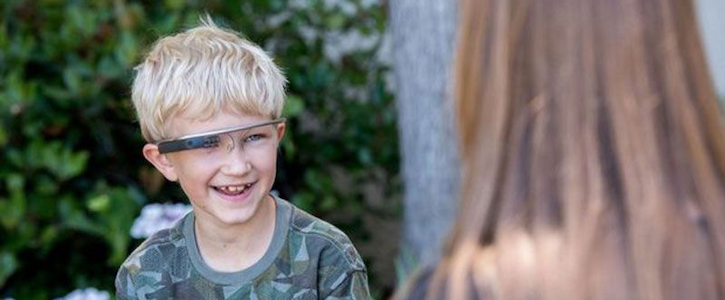Superpower Glass Improves Socialization in Children with Autism
The augmented reality wearable device helped children with autism spectrum disorder improve their social acuities.

Photo and thumbnail have been modified. Courtesy of Stanford.
Augmented reality digital therapy solutions can be an effective way to improve the social behavior of children with autism spectrum disorder, according to a new study published in JAMA Network.
Children who wore the Superpower Glass wearable technology, deployed via Google Glass, showed significant improvements on the Vineland Adaptive Behaviors Scale socialization subscale compared with treatment as usual controls. The 4.58-point average gain on the scale was comparable with the gains observed in standard of care therapy.
In the randomized clinical trial, Dennis Wall, Ph.D., associate professor in the departments of pediatrics, psychiatry and biomedical data science at Stanford University, and his team of researchers enrolled 71 children aged six to 12 years-old with a formal diagnosis of autism spectrum disorder. Participants were also receiving applied behavioral analysis therapy at least twice a week and scored greater than 15 on the Social Communication Questionnaire.
Of the 71 participants, 40 were randomized to treatment and 31 were randomized to control.
Those in the treatment group wore the Superpower Glass at home. The wearable technology tracks faces, classifies the emotions of the child’s social partners and provides two forms of cues to the child in real-time.
The smart glasses are made of three components: a green indicator box that lights the peripheral monitor when a face is detected within the outward-facing camera’s field of view. An emoji or emoticon shows up on the display and a robotic voice audio cue is played through the speaker of the glasses when a face is classified as expressing one of eight emotions by the machine learning model — happy, sad, angry, scared, surprised, disgust, “meh” and neutral.
All of the actions are recorded on the glasses and parents have access to a mobile app to manage the system. The app receives images, runs the emotion classifier and saves video and usage data.
The researchers provided three engagement activity modes: capture the smile, guess the emotion and free play.
In capture the smile, the child is prompted by audio to find an emotion in a family member’s face. For example, the child would tell their parent a joke and get her to laugh and be happy. In guess the emotion, the caregiver asks the child to guess the emotions they are acting and manually controls the response. Free play is an unstructured activity that gives the child emotional cues for all the individuals interacting with them.
The technology automatically logged the activities chosen and compiled videos of each session for the families to review.
The participants in the intervention group were asked to use each of the three engagement activities at least once and to use the device at home for 20 minutes three times per week with family members for six weeks. The children were also supposed to use the device once per week with their applied behavioral analysis interventionist.
Based on the collected data, participants preferred the structured games, with guess the emotion being played in 39.8 percent of the sessions.
The Vineland Adaptive Behavior scale showed a significant increase between the start and end of the intervention when comparing the treatment to control groups. The Social Responsiveness Scale showed larger positive mean changes in treatment participants compared with control participants.
It was found, however, that participants used the device on half as many days as initially recommended.
Wall told Inside Digital Health™ that adherence to the wearable technology could be enhanced if there were more games available on the system. Since the outcomes were already positive, Wall suggests that increased adherence would simply lead to even better outcomes.
According to the researchers, the intervention teaches children emotion recognition, facial engagement and the salience of emotion.
Wall said that the outcomes are extremely encouraging and that they warrant follow-up. He also said that there is a lot of hope and potential for this technology to be used to help enhance the social acuity of children with autism spectrum disorder.
The Glass technology has been licensed by Cognoa, a company that Wall founded, to move it through the channels to get approval and medical reimbursement coverage. Wall said that Cognoa will evaluate alternative wearable devices and put into context the feasibility and efficacy to advance the adaptability.
Wall said that the findings of the study showcase the potential of digital, mobile, ubiquitous solutions that can reach the homes of stakeholders. The device acts as a closed-loop to reinforce learning, which can foster coordination with care providers.
Navigate the digital transformation with confidence. Register for our newsletter.
Related
How a Video Game Could Help Children with Autism
Mobile Machine-Learning Program Predicts Autism with High Accuracy
2 Commerce Drive
Cranbury, NJ 08512
All rights reserved.